
The only 100% indigenous web magazine for
South African gardeners
inspiring Your indigenous garden
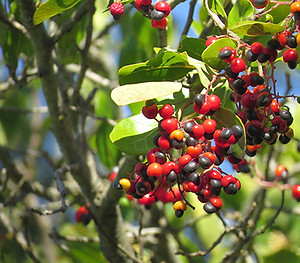
Apodytes dimidiata
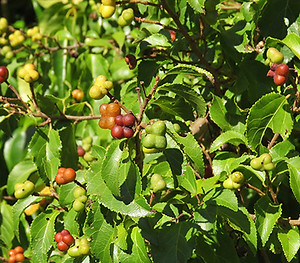
Grewia occidentalis
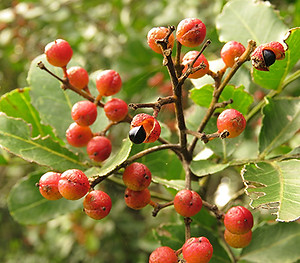
Zanthoxylum capense
Providing just a few thumbnail images in the body of the article allows for fast viewing. To view images in a pop-up album click links below image strips. Images can be shared or downloaded.
Autumn Fruits to feed the Birds
By Anno Torr
The autumn months are a crucial time for our fruit-eating birds, and they’ll be on the hunt for ripe berries and fruits before supplies tail off with winter’s arrival. To make things easier for them plant a few varieties from the list below. Many of these species have wide distribution ranges and habitats in which they thrive, making them particularly good choices for the home garden.
An important point to mention with regards to fruiting species: monkeys are an essential component of the habitats in which they move. They help to disperse seed over a large area and also deposit half-eaten fruits onto the floor making this food source available to ground-living species.
Fr – Heavy frost; Mf – Moderate frost; Lf – Light frost
SMALL - MEDIUM
The ice-pink flowers of Grewia occidentalis give way to beautiful orange fruits, up to four seeds encased in a bright orange pulpy skin. The Knysna Turaco, mousebirds, bulbuls and barbets love the fruits, and rural gardeners should plant a group of Grewia as food for a variety of mammals, like grey duiker, Nyala, Kudu, and farm cattle. Gardeners with a preference for yellow flowers can try Grewia monticola, a valuable tree for browsers during severe drought conditions. Baboons and monkeys eat the fruits, and they attract common garden birds too. 5 x 3 m. Fr
Cassinopsis ilicifolia. The Lemon Thorn is little used in urban gardens but would make an attractive and effective security hedge if planted on the boundary. And this is the perfect out-of-the-way position to attract avian visitors ranging from bulbuls, starlings, barbets, pigeons and francolins to feast securely in the thorny canopy. 2 – 5 x 4m; Fr
Searsia leptodictya. The Mountain Karee is another valuable tree that helps to feed browsers during drought conditions. It makes an attractive shade tree, screen, and street tree. The glossy, pale yellow-brown fruits are popular with a variety of fruit-eating birds. Its sister tree, Searsia pendulina, is one of the best species to attract garden birds – and feed the larvae of the Pearl Charaxes butterfly.
The Mountain Karee can grow 6 - 9 m but is more commonly a shrub of 3 – 4 x 5 m. Fr
Zanthoxylum capense. The Small Knobwood is a slender tree with the most interesting knobbly bark and clusters of green fruits that ripen to red, before splitting open to reveal a small oil-rich seed. A variety of fruit eaters feast on these, as do Vervet monkeys and baboons. Also a member of the Citrus family the leaves also host larvae of the Swallowtail butterflies. 5 x 3 m; Fr
Diospyros lycioides. The Bushveld Bluebush is a small decorative tree with a neat shape and large red berries from January to May. A tree for gardens visited by dassies. Fruits are also very popular with louries, mousebirds, barbets, bulbuls and starling. These large shrubs or small trees also make effective screens and hedges. 3 x 3 m; Fr
Rhamnus prinoides. Blinkblaar, Dogwood. For those with smaller gardens, the Blinkblaar is a beautiful large shrub or small tree for attracting birds to the garden. Fruiting continues for up to 6 months, from December to June; round and fleshy, about 5 mm in diameter, they change from green, then flush red and ripen to black attracting a variety of species, like barbets, starlings, bulbuls and francolins.
4 x 6 m; Fr
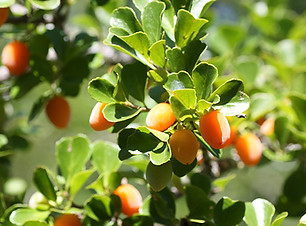
Dovyalis zeyheri

Rhamnus prinoides
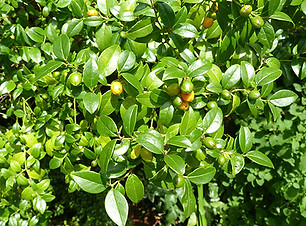
Cassinopsis ilicifolia
Pappea capensis. The Jacket-plum adapts it form to best suit its growing conditions and has delicious orange-red fleshy fruits that attract most fruit-eating birds. Mousebirds and barbets are especially partial to them. 6 x 7 m; Fr
Ziziphus mucronata. The Blinkblaar-wag-‘n-bietjie, or Buffalo Thorn, is a robust tree of great character – and excellent value for those living in drier areas. Many species of birds eat the fruits – Guinea fowl, francolins, parrots, louries and Burchell’ s coucals – and flowers attract the insect eaters. Leaves host the larvae of a few small butterflies, and flowers are a favourite with bees. 8 x 7 m; Fr
Dovyalis zeyheri, The Wild Apricot is a member of the Kei-apple Family, and, while ‘apricot’ may be one of the most delicious words in the English dictionary, the Wild Apricot has a somewhat unsavoury attribute; emitting a carrion-like stench at particular times of the year! Non-the-less, it is an attractive medium-sized tree with a light, open canopy and fleshy bright orange fruits with a furry, velvety texture from November to May. Ripe fruits are relished by pigeons, louries, mousebirds, barbets, bulbuls and starlings. And, if this crowd leave any to over-ripen, insects arrive, attracting insectivorous birds too. If that doesn’t get you out to a nursery to buy one, it is the host plant of the African Leopard butterfly! Anywhere from 2 – 13 m; Mf
The White Pear, Apodytes dimidiata is a neat, well- shaped and quite beautiful shade tree, spectacular when in fruit. An almost excessive volume of fruit in striking black and red, hang in dense, heavy-hanging bunches. The small black fruits are attached to a rather large and conspicuous red ‘heel’, creating an unusual and showy display from summer to autumn. Seeds bring in a variety of birds; Bulbuls, Starlings, pigeons, ground thrushes and Guinea fowl. 8 x 7 m; Lf
Vepris lanceolata is a member of the Citrus family and larval host plant for many of the Swallowtail butterflies. Leaves emit a delicious lemon scent when crushed, and this, together with the attractive, glossy, wavy and lance-like leaves make it popular with the landscaping trade. 4-lobed green fruits ripen to black attracting many bird species. Ripe fruits are insect magnets that entice in the insect-eating birds too! 7 – 10 m; Mf
Mimusops species: Milkwoods. The fleshy red fruits of Mimusops caffra, the Coastal Red-Milkwood, and M. zeyheri, Transvaal or Northern Red Milkwood, are produced in profusion from October onwards through much of the year. The Coastal Red-milkwood is usually a small to medium-sized tree and a perfect choice for coastal gardens, coping exceptionally well with both salty air and strong winds. Trees produce a profusion of yellow-orange to red fruits from April to September; edible when ripe, they are very popular with birds (louries, pigeons, barbets and bulbuls), baboons and vervet monkeys. M. zeyheri can grow to 15 m but is usually a shrub or small tree of 3 – 5 m; Mf
M. caffra has a variable height of 4 – 15 m; where it grows in the teeth of the wind will be a stunted, scraggy shrub of between 4 – 5 m. Frost tender - Lf
Searsia chirindensis: The well-known Red Current, or Bos-taaibos, produces its heavy crop of fruits at this time of year attracting pigeons, louries, bulbuls, barbets, Cape White-eyes, and Cape Parrots - and monkeys. An attractive shade tree with a fast growth, it tolerates both shade and sun. 9 x 7 m; Lf

Calodendrum capense

Vepris lanceolata

Olinia emarginata
MEDIUM - LARGE
Calodendrum capense. The Cape Chestnut is one of our most beautiful trees with large pale to dark pink flowers turning each specimen into a showstopper any time from July to March. Fruiting occurs from January to May and feeds mostly Cape Parrots, pigeons and doves along with Samango and Vervet monkeys. 11 m; Fr
Olinia emarginata. The Mountain Hard Pear is a beautiful evergreen tree whose rounded, dense canopy of glossy, dark green leaves show up well against the pale grey, peeling bark. Small pink to red drupe (stone-fruit to keep things simple) hang in dense clusters among the leaves. These feed a multitude of birds from March to July - pigeons, louries, bulbuls, bush blackcaps and crested barbets. It does not cope well with drought conditions. 10 x 8 m; Fr
Ilex mitis. African Holy, Cape Holy, Without. This under-utilised tree offers a belated Christmas feast in autumn, and one of a small selection of trees that is frost hardy though protection during the first couple of years is advisable. Bunches of tightly grouped bright red fruits bring in scores of birds from March to May. The Afrikaans name, Without, refers to the lovely white colour of the fine-grained wood, popular with furniture makers. 10 x 10 m; Fr
Croton sylvaticus. The Forest Fever-berry is a sizeable and shapely tree often used to provide shade in parking areas or parks. Large orange fruits make quite a show from December to May and are very popular with African Green Pigeons, doves, trumpeter Hornbills and Forest Weavers. Fallen fruits are snapped up by bushbuck, blue duiker and bushpigs, should you be lucky enough to have them visit your garden. From 12 – 16 m; Mf